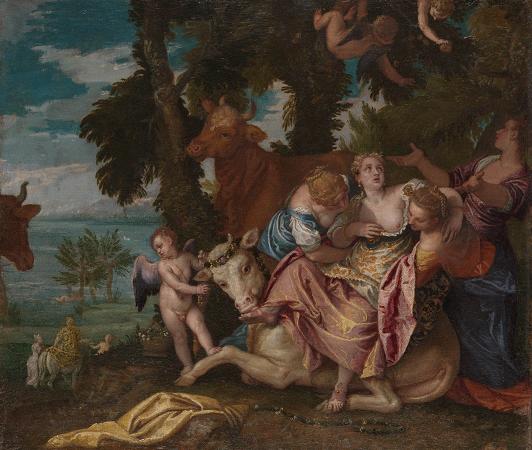Paolo Veronese (1528 - 1588). Paolo Caliari, known as Paolo Veronese, was an Italian Renaissance painter based in Venice, known for extremely large history paintings of religion and mythology, such as The Wedding at Cana and The Feast in the House of Levi. Included with Titian, a generation older, and Tintoretto, a decade senior, Veronese is one of the great trio that dominated Venetian painting of the cinquecento and the Late Renaissance in the 16th century. Known as a supreme colorist, and after an early period with Mannerism, Paolo Veronese developed a naturalist style of painting, influenced by Titian. His most famous works are elaborate narrative cycles, executed in a dramatic and colorful style, full of majestic architectural settings and glittering pageantry. His large paintings of biblical feasts, crowded with figures, painted for the refectories of monasteries in Venice and Verona are especially famous, and he was also the leading Venetian painter of ceilings. Most of these works remain in situ, or at least in Venice, and his representation in most museums is mainly composed of smaller works such as portraits that do not always show him at his best or most typical. He has always been appreciated forthe chromatic brilliance of his palette, the splendor and sensibility of his brushwork, the aristocratic elegance of his figures, and the magnificence of his spectacle, but his work has been felt not to permit expression of the profound, the human, or the sublime, and of the great trio he has often been the least appreciated by modern criticism. Nonetheless, many of the greatest artists. may be counted among his admirers, including Rubens, Watteau, Tiepolo, Delacroix and Renoir. Veronese took his usual name from his birthplace of Verona, then the largest possession of Venice on the mainland. The census in Verona attests that Veronese was born sometime in 1528 to a stonecutter, or spezapreda in the Venetian language, named Gabriele, and his wife Caterina. He was their fifth child. It was common for surnames to be taken from a father's profession, and thus Veronese was known as Paolo Spezapreda. He later changed his name to Paolo Caliari, because his mother was the illegitimate daughter of a nobleman called Antonio Caliari. His earliest known painting is signed P. Caliari F., the first known instance in which he used this surname, and after using Paolo Veronese for several years in Venice, after about 1575 he resumed signing his paintings as Paolo Caliari. He was often called Paolo Veronese before the last century to distinguish him from another painter from Verona, Alessandro Veronese, now known as Alessandro Turchi. By 1541, Veronese was apprenticed with Antonio Badile, who was later to become his father-in-law, and in 1544 was an apprentice of Giovanni Francesco Caroto; both were leading painters in Verona. An altarpiece painted by Badile in 1543 includes striking passages that were most likely the work of his fifteen-year-old apprentice; Veronese's precocious gifts soon surpassed the level of the workshop, and by 1544 he was no longer residing with Badile. Although trained in the culture of Mannerism then popular in Parma, he soon developed his own preference for a more radiant palette. In his late teens he painted works for important churches in Verona, and in 1551 he was commissioned by the Venetian branch of the important Giustiniani family to paint the altarpiece for their chapel in the church of San Francesco della Vigna, which was then being entirely rebuilt to the design of Jacopo Sansovino. In the same year he worked on the decoration of the Villa Soranzo near Treviso, with his fellow Veronese Giovanni Battista Zelotti and Anselmo Canneri; only fragments of the frescos remain, but they seem to have been important in establishing his reputation. The description by Carlo Ridolfi nearly a century later mentions that one of the mythological subjects was The Family of Darius before Alexander, the rare subject in Veronese's grandest treatment of secular history, now in the National Gallery, London. In 1552 Cardinal Ercole Gonzaga, great-uncle of the ruling Guglielmo Gonzaga, Duke of Mantua, commissioned an altarpiece for Mantua Cathedral, which Veronese painted in situ. He doubtless used his time in Mantua to study the ceilings by Giulio Romano; it was a painter of ceiling frescos that he would initially make his mark in Venice, where he based himself permanently from the following year. Veronese moved to Venice in 1553 after obtaining his first state commission, ceilings in fresco decorating the Sala dei Consiglio dei Dieci and the adjoining Sala dei Tre Capi del Consiglio in the Doge's Palace, in the new rooms replacing those lost in the fire of 1547.
more...














